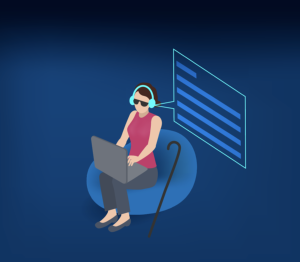
In our recent tip sheet from AccessATE and DeafTEC, we discussed accommodation and safety recommendations for employees who are blind or have low vision. The tip sheet briefly mentions that possible accommodations for blind/low vision workers are assistive technologies. Here, we’ll dive further into what some of those options are, and how they might be used.
Tip Sheet: Workplace Accommodations & Safety for Blind & Low Vision Employees
Many people are at least somewhat familiar with service dogs and canes for blind/low vision people, both of which are a type of mobility aid. Service dogs are trained to assist with specific tasks, such as guidance, locating and obtaining objects, alerting to obstacles and emergencies, and more. Service dogs are allowed anywhere the public is allowed, in accordance with the ADA. Some blind/low vision people learn to use a cane, which they tap or sweep along the ground in front of them to identify information like distance, texture, size, obstacles, and more. If a blind/low vision employee uses a cane, coworkers should be aware that the employee will need a little extra space around them to best utilize it. Another type of mobility aid is electronic mobility aids, which reflect ultrasonic waves off of obstacles and inform the user about what’s around them with sound or vibration. Electronic mobility aids are still in development, and often need to be used in tandem with a service dog or cane.
Some simple assistive technologies enable blind/low vision employees to access braille and large print. Braille is a tactile writing system that’s been around since the mid-1800s and utilizes bumps or embossing to enable reading by touch. Your business might purchase a braille printer, or utilize braille printing services, which we’ve mentioned before in the resources section of a previous blog post. A more modern option is a refreshable braille display, which provides access to information on screens by electronically raising and lowering different combinations of pins on a cell, which can be attached to a standard keyboard or be part of a braille keyboard. Refreshable braille displays might be preferable in certain environments because they provide more direct access to information, allow the user to check text formatting, spelling, and grammar, and are quiet. Employees with low (but some) vision might simply need large-print text or screen displays, or magnifiers. It’s easy for many companies to make large-print copies of physical documents, and there are many options for magnification software that can enlarge text and images on screens. Physical magnifiers or other optical devices may be appropriate for some low vision employees or work environments.
Moving on to wholly digital assistive technologies, we come to screen readers, speech synthesizers, and mobile apps. “Screen reader” is often used as a broad term to refer to software that reads text aloud, but is specifically the interface between a computer’s operating system and the user. Speech synthesizers, on the other hand, are text-to-speech systems that are often included with the purchase of a screen reader. Speech synthesizers are usually software but can have hardware components, and are good for the majority of digital reading. However, some names, compound words, and technical jargon might be difficult for a given speech synthesizer. Mobile apps like AccessNote and TapTapSee are becoming increasingly popular thanks to their versatility and, of course, mobility. Some apps are specialized for blind/low-vision users, while many others have blind/low vision-friendly accessibility features and modes. In all cases, they allow for easy voice control to accomplish various tasks, such as rich note-taking, identifying objects and colors, recognizing types of documents and images, and more.
There are many, many options when it comes to assistive technologies for blind/low vision employees. The exact one, or combination, will depend on an individual employee’s needs and the work itself. It’s best to sit down with the blind/low vision employee and discuss what has worked for them in the past, and to go over what will be expected of them at the current job. Remember that, in all cases, providing assistive technology is simply a tool to enable the employee to do their best!
Additional Resources
- Throughout this post, we linked to a number of pages from American Foundation for the Blind (AFB) that provide overviews of specific assistive technologies. Their page on Assistive Technology Products includes information on nearly two dozen different technologies, for every blind/low vision need you can think of!
- For more information on how to make your work environment generally more blind/low-vision-friendly, and on the benefits of hiring blind/low vision people, check out Make Your Workplace More Inclusive for Visually Impaired Employees.
- Accessible Technology for Visually Impaired Employees provides more detail on accessible technologies like screen reading software and voice labeling systems. The website that published the article, Starfire Dynamics, is a disabled-owned business that aims to make the world more accessible for all people with disabilities.




 See More Feature Articles
See More Feature Articles